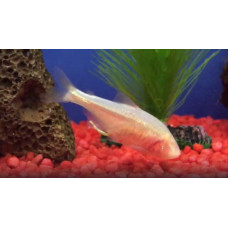Latin name
Anoptichthys jordani
Other name
Cave tetra, sardina ciega.
Identification
Astyanax jordani is very close to A. mexicanus and their taxonomic affiliation is controversial. Some consider them to be variants of the same species (in which case A. jordani is a junior synonym of A. mexicanus), and this is supported by phylogenetic data, but others continue to consider them separate species.
The body of Astyanax jordani is large, compressed at the sides. Males can be recognized by their more slender silhouette. The fish has lost its visual organs during evolution.
Features of fish fins
The fins of these fish are well developed, especially the anal fin with a lower acute angle. They have a split tail with rounded ends. There is an adipose fin.
Fish colouring
Astyanax jordani have no pigmentation at all. They appear pale pink with a slight metallic sheen due to the capillaries showing through the thin skin. During the spawning season, the male's fins become bright red.
Distribution
Widespread in North America: Mexico. Reportedly introduced into the Philippines.
Habitat
Tropical freshwater benthopelagic species. pH range: 6.0 - 7.8; dH range: ? -30.
Size
Maximum length for males is 10.0 cm.
Behavior
This species never migrates. This fish lives in complete darkness of cave reservoirs, deprived of natural sunlight. They are perfectly oriented among the surrounding objects, on the behavior of the fish it is difficult to say that it has no eyes. This is explained by unusually developed organs of the lateral line (especially - on the head), the functioning of which quite replaces vision.
Food and feeding habits
Astyanax jordani hatch from eggs with eyes. Initially the fry stay in the upper layers of the water and feed on zooplankton. Without eyes it would be difficult for them to catch shy infusoria and crustaceans. At the end of the second month of life, the fish go to feed on bottom invertebrates and sink to the depths. Here it is completely dark, and not all fish need eyes to catch slow-moving mollusks, so they are destroyed by overgrowing skin.
Reproduction
Astyanax jordani hatch from eggs with eyes. Initially the fry stay in the upper layers of the water and feed on zooplankton. Without eyes it would be difficult for them to catch shy infusoria and crustaceans. At the end of the second month of life, the fish go to feed on bottom invertebrates and sink to the depths. Here it is completely dark, and not all fish need eyes to catch slow-moving mollusks, so they are destroyed by overgrowing skin.
Fishing
This species is not commercially important. Fished for sale to aquariums only.
Relationship with a person
Harmless. This is an endangered fish due to declining populations and extremely limited, highly variable habitat, but it is quite resilient, with a doubling time of 15 months.
| Classification | |
| Phylum | Chordata |
| Class | Actinopterygii |
| Squad | Characiformes |
| Family | Characidae |
| Genus | Astyanax |
| Species | A. jordani |
| Features | |
| Conservation status | Endangered |
| Habitat | Pelagic |
| Life span, years | No information |
| Maximum body weight, kg | No information |
| Maximum length, cm | 10 |
| Sailing speed, m/s | No information |
| Threat to people | Not edible |
| Way of eating | Bentophage |
Astyanax jordani
Tags: astyanax jordani


